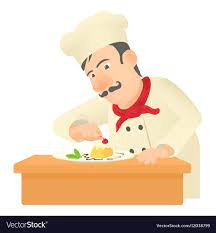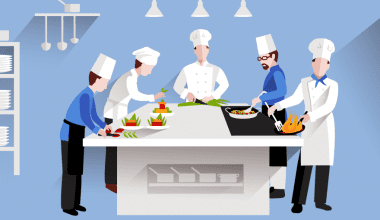Mon-Sat 9am-7pm



Food stylists specialize in crafting food displays that are aesthetically pleasing and designed to support product sales. They may work for a variety of organizations, including home shopping networks or creative consulting agencies. Food stylists may work varied hours, including on-call positions.
Specific job duties for food stylists will vary depending on their industry. General job responsibilities may include developing new recipes, creating a recipe database for social media accounts, sourcing ingredients by working with buyers or shopping for them, and preparing food. Food stylists may collaborate with other food stylists on best practices. They may also ensure the kitchen area is clean and hazard-free and maintain an inventory of ingredients. Food stylists can collaborate with the styling personnel on the best props for highlighting foods. They can also collaborate with advertising or editorial personnel on requests and deliverables.
Food stylists may be required to act on camera for instructional cooking videos. They may also present food displays to guests for review and make any suggested changes. Food stylists could work with the creative director to set a shooting schedule based on available personnel and upcoming projects.

A food stylist is responsible for adding style to food items for photography and videography. He or she makes it look marvellous and tasty with beautiful yet enticing arrangements.
A food stylist job comes with the responsibility of maintenance and cleanliness of the test kitchen or demonstration area for cooking equipment and utensils.
A food stylist has to consult with marketing as well as food production staff concerning the food items or which food recipes should be prepared for presentation or photography.
Before planning a shoot, a food stylist has to arrange all the props and accessories required in the food photography and videography to make it presentable by utilising silverware, plates and fabrics for food.
A food stylist is responsible for purchasing food ingredients, food items or recipe items required for presentation. While conducting live demonstrations, he or she has to organise supplies and ingredients by himself or herself.
With the ever-growing food industry, food stylist is becoming an essential part of the industry, especially for social media promotions. For becoming a successful food stylist, you need to pursue a professional course to learn about this field. A degree in Culinary Arts or chef courses can provide you with the required knowledge of food preparation as well as styling processes. There are several culinary schools that offer degrees, diplomas and certificates in Culinary Arts.
The demand for a food stylist in the market has exponentially increased with multinational food chains trying to expand their reach on social media. Although it is still a lesser-known career, a food stylist can enjoy incredible job opportunities in different sectors. However, the most prominent option that students consider is of opening their own restaurant or cafe. Here are the different areas where a food stylist can explore career prospects:
Food Stylists are amongst the most creative and popular careers in the digital world surging with food blogs on social media and are hired across hotel, food, catering as well as the travel industry. As per Payscale, the average salary of a Food Stylist is $62174 [45,43,741 INR] while the average salary of a Food Stylist in India as per Glassdoor is ?16,762 per month. With more experience and expertise in this field, you can further aim for a higher salary going up to ?40,000 per month.
You Can Be Creative
Cooking is an incredible way to express yourself and share your passion with others. As a chef, you’ll have the opportunity to create new dishes, experiment with unique ingredients, and maybe even come up with your own restaurant concept someday. Culinary arts is an amazing field for individuals who want to showcase their creativity through food.
You Can Work for Yourself
If you’re an independent individual who values flexibility, culinary arts is full of potential. Restaurants are always seeking skilled cooks and chefs, so career opportunities abound when you’re ready to learn new techniques, move to a different location, or simply find a change of pace. You could also consider a career as a personal chef for even greater flexibility and freedom.
There Are Great Salary Opportunities
Once you climb through the kitchen ranks and put in some years into the industry, it’s possible to earn a comfortable salary as a chef. That’s particularly true if you land a job at a high-end restaurant, resort, or hotel.
What can you expect to make as a chef? As of 2019, Executive Chefs nationwide earn an average salary of $68,000 per year, though that number is higher in major cities like Los Angeles ($77,000 per year) and New York ($82,000 per year).
You Work with Talented People
A career in culinary arts is a great way to surround yourself with creative, motivated, and independent people—just like you! The restaurant industry is filled with incredibly talented individuals, and you’ll have the opportunity to receive mentorship and collaborate with other passionate chefs every day in the kitchen.
:It Can Be Unstable
The restaurant business is notoriously fickle, and things can change at a moment’s notice. Many restaurants fail for reasons totally unrelated to food; a difficult landlord, a bad business deal, or one unfavorable review may mean you’re out of a job as a chef. This con can be especially scary if you have a family that relies on your income, so you’ll need to determine if you’re able to accept the risk.
You Will Work Long, Difficult Hours
Working in restaurants means working when people want to eat—even if that’s early in the morning, late at night, all weekend long, and likely on most major holidays. It’s not uncommon to work 10 to 12-hour shifts. Because chefs often have a challenging and inconsistent schedule, balancing a culinary career with a personal life can be tough.
Starting Salaries Are Low
While it’s possible to bring home a solid paycheck as an Executive Chef, most culinary professionals have to work their way through a variety of lower-paying jobs before they reach the top spot in a restaurant. Entry level cooks often start out making minimum wage, even at higher-end restaurants, and it can take years to make your way up through the ranks—so it’s important to be realistic about your salary early in a culinary career.
It’s Physically Demanding
Working in culinary arts takes a lot of energy, and you’ll likely have some scars to show for your years as a chef. In most kitchens, you’ll spend long hours standing and work with sharp knives, hot pans, and open flames. When thinking about a culinary career, make sure you’re physically capable of taking the heat before you step into the kitchen.
Call us at +91 9205084085, Monday - Friday, 9 am - 7 pm


